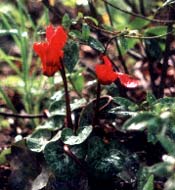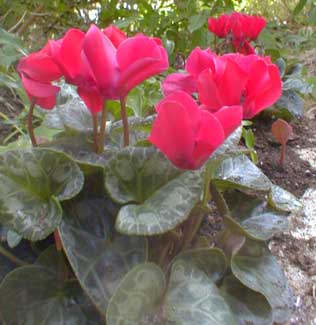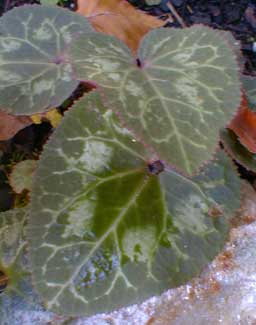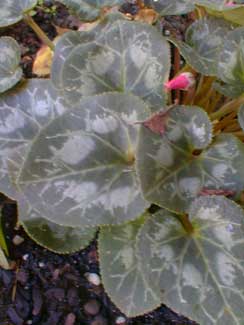
'Laser Scarlet' Persian Violet;
or, Red Florist's Cyclamen
"And your cyclamen stand by our wayside
To tell us that we too have our roots deep in earth"
-Kahlil Gibran
 In May (2002), I planted Cyclamen persicum 'Laser Scarlet' in our temperate garden. I knew that the multitude of fancy "Florist's Cyclamens" were delicate even as houseplants & not apt to survive in the garden. But Puget Sound has a mild micro-climate that places our gardening conditions right on the cusp of what is feasible for the hardiest cultivars of frost-sensitive C. persicum, even though they would always be at least a bit at risk.
In May (2002), I planted Cyclamen persicum 'Laser Scarlet' in our temperate garden. I knew that the multitude of fancy "Florist's Cyclamens" were delicate even as houseplants & not apt to survive in the garden. But Puget Sound has a mild micro-climate that places our gardening conditions right on the cusp of what is feasible for the hardiest cultivars of frost-sensitive C. persicum, even though they would always be at least a bit at risk.The 'Laser' series constitutes nineteen unusually bright color varieties, in in small & large flowering forms. C. persicum or Persian Violet cultivars are extremely varied in small, medium, & large-flowered versions, the majority inappropriate for our zone. Our 'Laser Scarlet' has small instensely red blooms. The regular wild, small-flowering Pink Persian Violet is surprisingly easy to grow in a protected shady spot on Puget Sound, & will bloom every year, but most cultivated varieties just won't make it through even our mild winters. The possible exceptions are among the small-flowering forms which are the most like the wild species.
 The species & some of its small-flowering florist cultivars can tolerate very short-term frosts, but one never knows for sure until a is tested. The 'Laser Scarlet' planted in 2002 has reliably re-leafed every autumn, but has not bloomed every year.
The species & some of its small-flowering florist cultivars can tolerate very short-term frosts, but one never knows for sure until a is tested. The 'Laser Scarlet' planted in 2002 has reliably re-leafed every autumn, but has not bloomed every year.The so-called 'Mother's Day Cyclamen' is a grower-imposed name for 'Laser Scarlet' when forced to bloom on Mother's Day, the biggest sales day for nurseries every year. Imagine my surprise that first year when the 'Laser Scarlet' bloomed non-stop through the entirety of spring & summer of 2002 (the bad photo at top was snapped in July 2002).
The majority of cyclamen species go dormant in summer, but C. persicum being somewhat the exception, having such a quick aestivation period it can seem never to be dormant at all, though even so it should be only leaves during the hot days & wait to bloom until autumn or later. Yet here was this one continuously in bloom from May until the beginning of September, when it finally quit. The leaves died back but began to reappear surprisingly soon, in late January (2003).
 A series of very frosty nights & mornings in February did not seem to hurt this variety, but the leaves were quite slow to bush up. In 2003 & 2004 the 'Laser Scarlet' did not bloom, though they produced lovely leaves. In 2004 it was summer-dormant & produced no leaves until autumn, so there's a strange unpredictability about its habits each year, like it has forgotten how to mark its seasons. Eventually I moved three 'Laser Scarlet' tubers from deep shade to bright shade. In 2005 they bloomed in September.
A series of very frosty nights & mornings in February did not seem to hurt this variety, but the leaves were quite slow to bush up. In 2003 & 2004 the 'Laser Scarlet' did not bloom, though they produced lovely leaves. In 2004 it was summer-dormant & produced no leaves until autumn, so there's a strange unpredictability about its habits each year, like it has forgotten how to mark its seasons. Eventually I moved three 'Laser Scarlet' tubers from deep shade to bright shade. In 2005 they bloomed in September.During its first August one tuber appeared to have pushed itself up out of the ground & was floating in the air with a single slender woody upright stem underneath. The tuber (often mistakenly called a "corm") was disc shaped with roots winding downward from the top & stems of flowers & leaves reaching up. I had no idea why it lifted itself out of the soil, though in areas where there are not even mild frosts, they are the only cyclamens that should have the top of the tuber bared to the atmosphere. It didn't seem quite right sticking entirely in the air, so I built the soil up a bit to get it back under the earth, though only barely.
For our weather conditions on Puget Sound, 'Laser Scarlet' Cyclamen is regarded as a tender perennial that may or may not make it through winter; some would recommend having it indoors for winter then back out in spring. Ours has succeeded year-round outdoors but to be frank, its success is nowhere near as impressive as sundry varieties of C. coum & C. hederifolium, or even the wild C. persicum.
The instructions for the care of the 'Laser Scarlet' cyclamen if kept indoors struck me as burdensome, as though the plant were a combination of African Violet & rare orchid, except even more delicate. I won't repeat those instructions since I didn't follow any of them & most people who have them as houseplants just toss them after their first year. By & large it is inappropriate to place C. persicum cultivars in gardens below Zone 9, but our experience with small-flowering 'Laser Scarlet' is that it is worth popping them into a protected shady spot in a Zone 8 garden where they provide lovely winter & spring foliage sometimes lasting well into summer, but may skip blooming some years.
Continue to
Cyclamen intaminatum
miniature pattern-leaf cyclamen